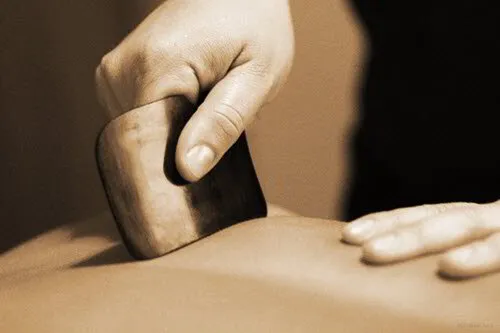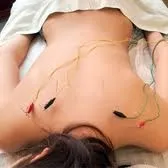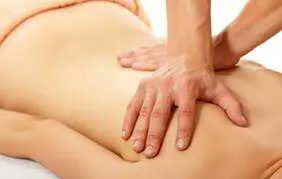Other Treatments
Other Treatments
These treatments are often used in combination with acupuncture.
Cupping
Cupping is used to move Qi and blood in the muscles, joints and channels helping to alleviate pain and improve circulation. The suction from the cup draws up skin and fascia to release myofascial and soft tissue tension.
The cups can be static or gliding. Cupping feels like a reverse massage, for most patients, this is a particularly relaxing & relieving sensation.
Gua sha
Gua sha uses a smooth-edged tool to apply repeated even strokes over the skin. Gua sha increases microperfusion in the area treated (1). This causes the release of chemical mediators which increase blood circulation, decrease nerve irritation and decrease inflammation (2). This helps relieve pain. Gua sha is effective for neck pain (3) and is also commonly used to relieve muscle tension and on the lower back & thighs for relief of sciatic pain.
Moxa
Moxa is a modality of Chinese medicine. Moxa is a preparation of leaves from the mugwort plant ground up to a 'fluff' and then burnt. It can be used directly on the skin to warm acupuncture points before needling or to warm a larger area using a moxa stick. Research has focussed on the use of moxa for relief of osteoarthritis knee pain (4) but patients find it beneficial for other forms of arthritic pain and discomfort.
Electroacupuncture
Electroacupuncture (EA) is a form of acupuncture where a small current is passed between two needles. It can induce an analgesic effect on the central and peripheral nervous system (5)(6). It is used for pain management as it promotes the release of endogenous neurotransmitters, such as beta-endorphin, serotonin & dopamine, all natural analgesics (7)(8)(9) . EA may help to stimulate the body's healing process (10)(11)(12) and effect blood flow making it a useful treatment to relax muscles and repair tissue damage.
Tui Na
Tui na is a therapeutic form of massage based on the principles of Chinese Medicine. It works with the channels and acupuncture points to promote and invigorate the flow of Qi and blood to release & relax fascia & soft tissue and facilitate the movement of joints. It is an effective form of treatment for digestive and gynaecological problems when using abdominal release techniques. Patients find Tui na to be both a stimulating and relaxing treatment.
Research articles referenced
(1) Neilsen A; Knoblauch N; Dobos G et al., 2007. The effect of 'Gua sha' treatment on the microcirculation of surface tissue: a pilot study in healthy subjects. EXPLORE: The Journal of Science & Healing 3; 456 - 466
(2) Hancock C.M, Riegger-Krugh C, 2008: Modulation of pain in osteoarthritis: the role of nitric oxide. Clin J Pain 24 (4) (May); 353 - 365
(3) Bruan M, Schwickert M, Nielsen A et al., 2011. Effectiveness of Traditional Chinese 'Gua sha' Therapy in patients with chronic neck pain; a randomised controlled trial. Pain Med January 28.
(4) Zhao L, et al. 2014: Effectiveness of moxibustion treatment as adjunctive therapy in osteoarthritis of the knee a randomized, double-blinded, placebo-controlled clinical trial. Arthritis Research & Therapy 16; R133
(5) Heish et al., 2000. Analgesic effect of electric stimulation of peripheral nerves with different electric frequencies. American Journal of Chinese Medicine 28 (2); 291 - 299
(6) He, L. 1987. Involvement of endogenous opiod peptides in acupuncture analgesia. Pain 31 (1); 99 - 121
(7) Leung, L. 2012. Neurophysiological basis of acupuncture induced analgesia - an updated review. Journal of Acupuncture Meridian Studies 5, 6; 261 - 270
(8) Yoo, Y, et al., 2011. Analgesic mechanisms of electroacupuncture in an arthritic pain model of rats: a neurotransmitter study. Yansei Medical Journal 52 (6); 1016 - 1021
(9) Zhao L., 2008. Neural mechanisms underlying acupuncture analgesia. Progress in Neurobiology 85 (4); 355 - 357
(10) Beck, B. et al., 2008. Do capacitively coupled electric fields accelerate tibial stress fracture healing? A randomised controlled trial. American Journal of Sports Medicine 36; 545 - 553
(11) Meng SY, Rouabhia M & Zhang Z., 2011. Electrical Stimulation in Tissue Regeneration. www.intechopen.com, accessed 9 Aug 2022
(12) Gordon T. et al., 2009. Brief electrical stimulation accelerates axon regeneration in the PNS and promotes sensory axon regeneration in the CNS. Motor Control 13; 412 - 441
What happens next
To discuss your condition or to book an appointment
call Victoria on 07939 117 460 or





